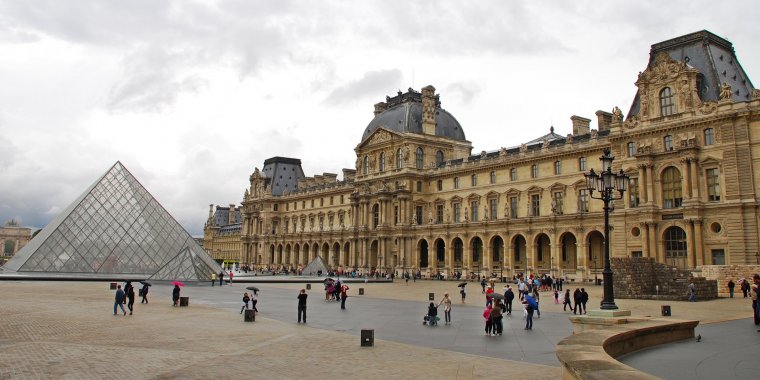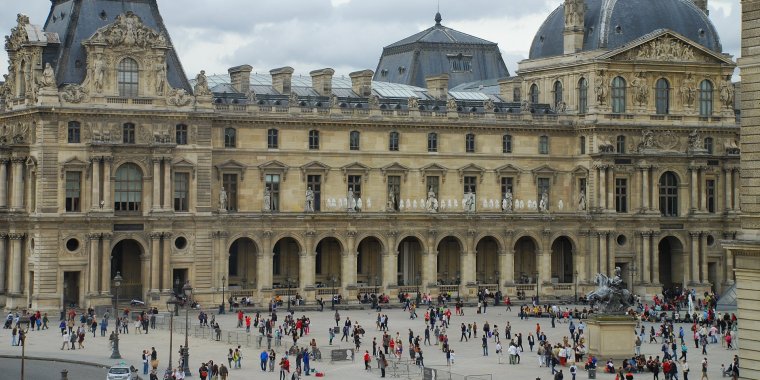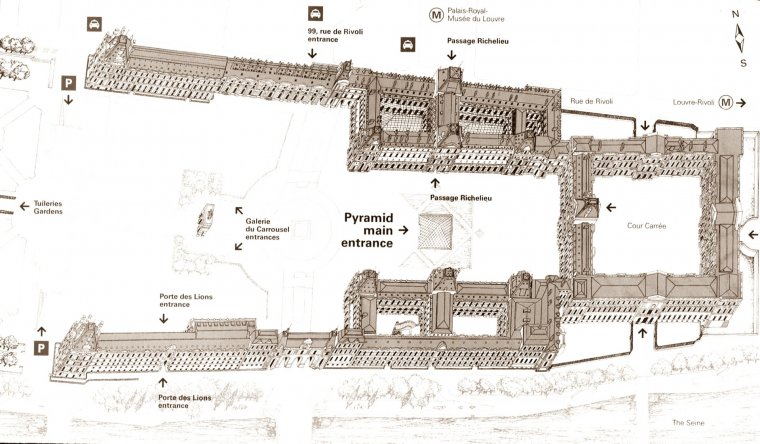| Travel / Tourist Attractions |
Louvre Museum, Paris, France

The Louvre Palace. Photo: Cătălin Kislinger / Titi Tudorancea Bulletin.
The Louvre or the Louvre Museum (Musée du Louvre), is the world's largest museum and a historic monument in Paris, France. A central landmark of the city, it is located on the Right Bank of the Seine in the city's 1st arrondissement (district or ward).
The Louvre is the world's second most visited museum after the Palace Museum in China, receiving more than 9.26 million visitors in 2014.
The museum is housed in the Louvre Palace, originally built as a fortress in the late 12th century under Philip II. Remnants of the fortress are visible in the basement of the museum. Due to the urban expansion of the city, the fortress eventually lost its defensive function and, in 1546, was converted by Francis I into the main residence of the French Kings. The building was extended many times to form the present Louvre Palace.
In 1682, Louis XIV chose the Palace of Versailles for his household, leaving the Louvre primarily as a place to display the royal collection, including, from 1692, a collection of ancient Greek and Roman sculpture. In 1692, the building was occupied by the Académie des Inscriptions et Belles Lettres and the Académie Royale de Peinture et de Sculpture, which in 1699 held the first of a series of salons. The Académie remained at the Louvre for 100 years.
During the French Revolution, the National Assembly decreed that the Louvre should be used as a museum to display the nation's masterpieces.
The museum opened on 10 August 1793 with an exhibition of 537 paintings, the majority of the works being royal and confiscated church property. Because of structural problems with the building, the museum was closed in 1796 until 1801. The collection was increased under Napoleon and the museum renamed the Musée Napoléon, but after Napoleon's abdication many works seized by his armies were returned to their original owners.
The collection was further increased during the reigns of Louis XVIII and Charles X, and during the Second French Empire the museum gained 20,000 pieces. Holdings have grown steadily through donations and bequests since the Third Republic. The collection is divided among eight curatorial departments: Egyptian Antiquities; Near Eastern Antiquities; Greek, Etruscan and Roman Antiquities; Islamic Art; Sculpture; Decorative Arts; Paintings; Prints and Drawings.
The Musée du Louvre contains more than 380,000 objects and displays 35,000 works of art in eight curatorial departments with more than 60,600 square metres (652,000 sq ft) dedicated to the permanent collection. The Louvre exhibits sculptures, objets d'art, paintings, drawings, and archaeological finds. It is the world's second most visited museum, averaging 15,000 visitors per day, 65 percent of whom are foreign tourists.
Location, access, and facilities
The museum lies in the center of Paris on the Right Bank.
Musée du Louvre, Place du Carrousel (Métro: Louvre), ☎ +33 1 40 20 53 17. Open daily 10am-6pm, closed Tuesdays and some public holidays, evening openings We and Fr until 9.45pm, 1st Su of the month.
Free admission for all, general admission (not including special exhibitions) adults € 12, EU-peoples under 26 years free, exhibitions in the Hall Napoléon € 13; combined ticket (museum + spezial exhibitions) adults € 16 Carte Musée.
The Louvre has three entrances: the main entrance at the pyramid, an entrance from the Carrousel du Louvre underground shopping mall, and an entrance at the Porte des Lions (near the western end of the Denon wing). Under the main entrance to the museum is the Carrousel du Louvre, a shopping mall operated by Unibail-Rodamco.
The use of cameras and video recorders is permitted inside, but flash photography is forbidden.
Its exhibits come from such diverse origins as ancient Egypt, classical Greece and Rome, medieval Europe and Napoleonic France. Its most famous exhibit, of course, is Leonardo da Vinci's painting of the Mona Lisa, generally to be found surrounded by hordes of camera-flashing tourists.
If you want to see everything in the Louvre, plan at least two full days. However, it is better to pick and choose, as the collection was assembled with an eye to completeness rather than quality.
Located in the heart of Paris, the Louvre Museum is easily accessible from any means of transport.
By Metro. Palais Royal - Musée du Louvre (1), (7)
By bus. Palais Royal - Musée du Louvre (BUS) 21, 48, 69, 72, 81; Quai François Mitterand (BUS) 24, 27, 69; Musée du Louvre (BUS) 27, 39, 68, 69, 95.
By bike. The Louvre Museum is served by five Vélib stations:
• André Malraux 2, Place André Malraux 75001 Paris
• André Malraux - Musée du Louvre 165, rue Saint-Honoré 75001 Paris
• Rue Saint-Honoré 186, rue Saint-Honoré 75001 Paris
• Rivoli - Musée du Louvre 5, rue de l’Échelle 75001 Paris
• Temple de l'Oratoire 2, rue de l'Oratoire 75001 Paris
By car. Parking Louvre Avenue du Général Lemonnier 75001 Paris, Logo indiquant un numéro de téléphone +33 1 53 45 22 70 Logo indiquant des horaires 7 h - 23 h. Logo indiquant des tarifs De 3 € à 55 €. Located under the Tuileries Garden, this underground car park has 670 seats.

The Louvre Palace. Photo: Cătălin Kislinger / Titi Tudorancea Bulletin.

Map of the Louvre Museum. Photo: Cătălin Kislinger / Titi Tudorancea Bulletin
YOU MAY ALSO LIKE





